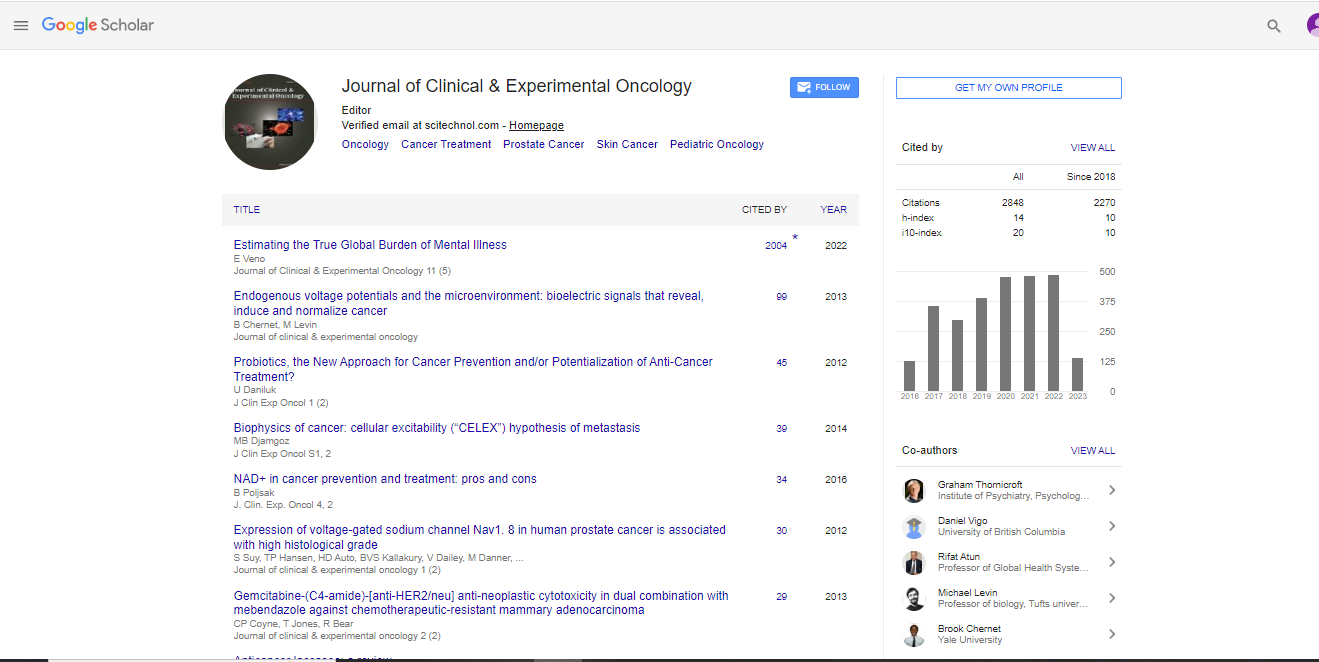Short Communication, J Clin Exp Oncol Vol: 13 Issue: 2
Enhancing Tumor Immunology's Impact on Cancer Progression and Therapy
Lin Xiyung*
1Department of Cancer Biology, Sichuan University, Chengdu, China
*Corresponding Author: Lin Xiyung,
Department of Cancer Biology, Sichuan
University, Chengdu, China
E-mail: linxiyung@su22.cn
Received date: 22 May, 2024, Manuscript No. JCEOG-24-143932;
Editor assigned date: 24 May, 2024, PreQC No. JCEOG-24-143932 (PQ);
Reviewed date: 07 June, 2024, QC No. JCEOG-24-143932;
Revised date: 14 June, 2024, Manuscript No. JCEOG-24-143932 (R);
Published date: 21 June, 2024, DOI: 10.4172/2324-9110.1000417
Citation: Xiyung L (2024) Enhancing Tumor Immunology's Impact on Cancer Progression and Therapy. J Clin Exp Oncol 13:2.
Description
Tumor immunology, the study of the interactions between the immune system and cancer cells, has revolutionized the understanding of cancer biology and treatment. The immune system plays a dual role in cancer, capable of both suppressing and promoting tumor development. Optimising and enhancing the immune system's ability to fight cancer has led to significant advances in cancer therapy, most notably in the field of immunotherapy [1]. It explores the fundamental concepts of tumor immunology, its impact on cancer progression, and the innovative therapeutic strategies derived from this knowledge. The immune system is designed to protect the body from foreign invaders, such as viruses and bacteria, as well as abnormal cells, including cancer cells [2].
It consists of various components, including innate and adaptive immunity. Innate immunity provides immediate, non-specific defense, while adaptive immunity involves a specific, long-term response mediated by T cells and B cells. One of the key roles of the immune system is immune surveillance, the process by which immune cells recognize and eliminate nascent tumor cells [3]. T-cells, particularly Cytotoxic T Lymphocytes (CTLs), play a key role in identifying and destroying cancer cells presenting abnormal antigens on their surface. Natural Killer (NK) cells and macrophages also contribute to this process by targeting and killing tumor cells [4]. Despite the immune system's ability to recognize and attack cancer cells, tumors often develop mechanisms to evade immune detection and destruction.
Tumor cells can reduce the expression of Major Histocompatibility Complex (MHC) molecules, which are essential for presenting tumor antigens to T cells. Tumors can secrete cytokines and growth factors, such as Transforming Growth Factor-beta (TGF-β) and Interleukin-10 (IL-10), that suppress immune responses [5,6]. Tumor cells can express proteins such as Programmed Death-Ligand 1 (PD-L1) that bind to inhibitory receptors on T cells, effectively turning off the immune response. The Tumor Micro Environment (TME) is a complex and dynamic network of cancer cells, immune cells, stromal cells, blood vessels, and extracellular matrix components [7]. The TME plays a vital role in cancer progression and the response to therapy. It can both promote and inhibit tumor growth, depending on the composition and activity of its components. The TME contains various immune cells, including Tumor-Associated Macrophages (TAMs), Myeloid-Derived Suppressor Cells (MDSCs), regulatory T cells and Dendritic Cells (DC) [8].
TAMs and MDSCs often promote tumor growth and suppress antitumor immunity, while regulatory T cells inhibit effector T cell function. On the other hand, activated CTLs and NK cells within the TME can target and kill cancer cells. Chronic inflammation in the TME can promote tumor growth by developing a favorable environment for cancer cells to thrive. Inflammatory cells release cytokines and growth factors that support angiogenesis, tissue remodeling, and immune suppression. Recent advances in the understanding of tumor immunology have led to the development of novel therapeutic strategies aimed at enhancing the immune system's ability to combat cancer. These approaches include immune checkpoint inhibitors, adoptive cell transfer, cancer vaccines, and oncolytic viruses [9].
Immune checkpoints are regulatory pathways that maintain selftolerance and prevent autoimmunity. Tumors exploit these pathways to evade immune detection. Checkpoint inhibitors, such as anti-PD-1, anti-PD-L1, and anti-CTLA-4 antibodies, block these inhibitory signals, allowing T cells to recognize and attack cancer cells. Drugs like pembrolizumab and nivolumab have shown remarkable success in treating various cancers, including melanoma, lung cancer, and renal cell carcinoma. Adoptive Cell Transfer (ACT) involves the infusion of autologous or allogeneic T cells that have been expanded and activated ex vivo [10]. One of the most effective forms of ACT is Chimeric Antigen Receptor (CAR) T cell therapy. CAR-T cells are genetically engineered to express receptors that target specific tumor antigens. This therapy has demonstrated significant efficacy in treating hematological malignancies, such as Acute Lymphoblastic Leukemia (ALL) and non-Hodgkin lymphoma.
Conclusion
Tumor immunology has significantly advanced the understanding of cancer progression and therapy. By elucidating the interactions between the immune system and cancer cells, experts have developed innovative immunotherapeutic strategies that have transformed cancer treatment. Immune checkpoint inhibitors, adoptive cell transfer, cancer vaccines, and oncolytic viruses represent some of the most potential approaches to enhance the immune system's power. However, challenges such as tumor heterogeneity, immune-related adverse events, and the immunosuppressive tumor microenvironment need to be addressed to maximize the impact of these therapies. Continued studies and clinical trials are essential to refine these strategies, overcome existing challenges, and ultimately improve outcomes for cancer patients.
References
- Galon J, Bruni D (2020) Tumor immunology and tumor evolution: intertwined histories. Immunity 52(1):55-81.
- Raval RR, Sharabi AB, Walker AJ, Drake CG, Sharma P (2014) Tumor immunology and cancer immunotherapy: summary of the 2013 SITC primer. J Immunother Cancer 2:1-3.
- Sarkar S, Horn G, Moulton K, Oza A, Byler S, et al.( 2013) Cancer development, progression, and therapy: an epigenetic overview. Int J Mol Sci 14(10):21087-21113.
- Marei HE, Althani A, Afifi N, Hasan A, Caceci T, et al. (2021) p53 signaling in cancer progression and therapy. Cancer Cell Int 21(1):703.
- Mao X, Xu J, Wang W, Liang C, Hua J, et al. (2021) Crosstalk between cancer-associated fibroblasts and immune cells in the tumor microenvironment: new findings and future perspectives. Mol cancer 20(1):1-30.
- Yoshida GJ (2020) Applications of patient-derived tumor xenograft models and tumor organoids. J Hematol Oncol 13(1):1-6.
- Mhaidly R, Mechta‐Grigoriou F (2021) Role of cancer‐associated fibroblast subpopulations in immune infiltration, as a new means of treatment in cancer. Immunol Rev 302(1):259-272.
- Qiu G-Z, Jin M-Z, Dai J-X, Sun W, Feng J-H, et al. (2017) Reprogramming of the tumor in the hypoxic niche: The emerging concept and associated therapeutic strategies. Trends Pharmacol Sci 38:669-686.
- Bhandari V, Hoey C, Liu LY, Lalonde E, Ray J, et al. (2019) Molecular landmarks of tumor hypoxia across cancer types. Nat Genet 51:308-318.
- Prager BC, Xie Q, Bao S, Rich JN (2019) Cancer stem cells: The architects of the tumor ecosystem. Cell Stem Cell 24:41–53.
 Spanish
Spanish  Chinese
Chinese  Russian
Russian  German
German  French
French  Japanese
Japanese  Portuguese
Portuguese  Hindi
Hindi 



